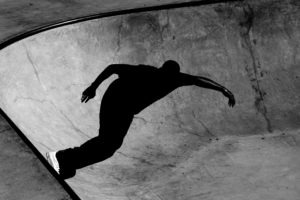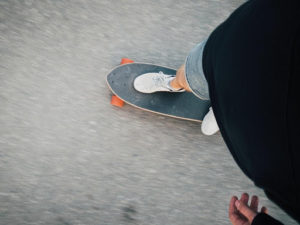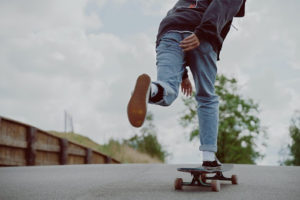So, you’ve learned how to discover your stance, push off, ride, and turn on your skateboard…congratulations! You’re one step closer to moving on the best part: free skating and learning tricks. However, before you start practicing and performing tricks, you need to learn how to fall. A fall every now and then is inevitable and learning the correct way to fall off your skateboard can help prevent serious injuries.
“Wait, you mean there’s a correct way to fall?” Yes, there is a correct way to fall! Or rather, there are more effective ways to fall. If you fall improperly, you risk injuries such as broken bones, even from shorter heights.
“Wait, broken bones?!” No need to sound the alarm. While it’s important to understand the risks involved with skateboarding, psyching yourself out over possible injuries won’t do you any good. Instead, focus that energy on practicing proper form, including how to fall, to keep risk of injury to a minimum.
What You’ll Need
- Helmet. You should be wearing a helmet every time you ride, not just when practicing falls, but for the sake of emphasis, keep a lid on it! Make sure to wear it properly (buckle the straps) and make sure it fits your head snugly all around.
- Pads. Practicing how to fall is unnatural. Wearing extra protective gear such as elbow pads, knee pads, and wrist guards can give you some peace of mind knowing you’ve got a little extra cushioning on your side. If you do decide to wear wrist guards, don’t use them as an excuse to land on your wrists (more on this later).
- Skate shoes. You should be wearing slip-resistant skate shoes that provide enhanced grip and allow your feet to feel the board more accurately.
How to Prevent Falling
An ounce of prevention is worth a pound of cure! Or something like that.
Before we get into how to fall should the occasion arise, we need to emphasize ways to prevent falls from happening in the first place.
- Pay attention to your surroundings. Just as distractions can be dangerous when driving, they can be dangerous when you’re skateboarding. Don’t maintain tunnel vision and keep scanning your environment. Sweep the ground before you with your eyes to check for any cracks or bumps that might send you flying. Even a small chip in the pavement can be enough to knock you off. Keep your eyes peeled for people so you can avoid collisions at the skatepark.
- Ride in a safe environment. We know that a “safe” environment can be open to interpretation, but when you’re practicing falls, we recommend practicing in a spot where concrete meets grass. Once you’ve mastered falling and are out skating “for real,” use your best judgment when deciding where to skate. Know your limits and avoid taking on obstacles that are above your skill level.
- Practice. The only way to get better at skateboarding is to practice. There’s no way to prevent every fall but working on your balance and strength can improve your coordination.
How to Fall on a Skateboard
Tucking and Rolling
Rolling is probably the most effective way to fall, especially when skating bowls at the skatepark. If possible, find a spot to practice where concrete meets grass.
- Starting with your skateboard on the concrete, push off once or twice towards the grass.
- As soon as you reach the “grass threshold” and the board slows or stops, let your body fall forward.
- Immediately after you start to fall, tuck your head, and lead shoulder in, and roll as if you were going into a somersault.
The goal of rolling is to protect your head and other bony body parts, and instead land on fleshier parts such as your butt, back, or stomach.
Run Out or Run Off
Another way to “fall” is to learn how to run out of tricks. If you are riding or about to perform a trick and feel you’re about to lose control, you can catch yourself by running off your skateboard and “out of it.” The key is to sustain your momentum. Additionally, you can slide off on your knee pads if you’re in a ramp or bowl.
How Not to Fall on a Skateboard
- Don’t use your hands or wrists to break your fall. This can be difficult, as instinct prompts us to throw our hands out when we fall. But using your hands to break your fall, especially on concrete, can result in broken wrists. Wrist guards can help if you’re afraid of accidentally catching yourself with your hands, but don’t let them encourage you to fall on your wrists.
- Don’t tense up. Falling with stiff joints can lead to greater injuries. Even though tensing up is an automatic reaction for the body, try to retrain yourself to let your body relax when you’re about to fall. This can help prevent or lessen any issues.
- Don’t flail your arms. When you start to lose your balance, a natural reaction is to start flailing around. While using your arms can help with balance, flailing rapidly in random directions make it harder to regain balance.
For more skateboarding best practices, check out our general skateboarding safety tips!








